KSysGuard/zh-tw: Difference between revisions
Appearance
m Created page with "系統負載" |
Updating to match new version of source page |
||
| (14 intermediate revisions by 2 users not shown) | |||
| Line 2: | Line 2: | ||
{|class="tablecenter vertical-centered" | {|class="tablecenter vertical-centered" | ||
|[[Image:Ksysguard1.png|thumb|265px|系統負載]]|| ''' | |[[Image:Ksysguard1.png|thumb|265px|系統負載]]|| '''追蹤和控制系統中的行程。''' | ||
|} | |} | ||
== | ==概述== | ||
'''KSysGuard''' | <span class="mw-translate-fuzzy"> | ||
'''KSysGuard''' 設計成無需使用者特別設定即可進行簡單的行程控制 - 預設的通常完全夠用。有兩張工作表 - <menuchoice>系統負載</menuchoice>頁(上面是圖表)和<menuchoice>行程表</menuchoice>。 | |||
</span> | |||
== | ==系統負載== | ||
<menuchoice>系統負載</menuchoice>屏有3個顯示圖表,每個分別描繪如下負載要素- 「CPU歷史」,「記憶體和Swap歷史」,「網絡歷史」。如果你懸停鼠標指針到每個部分的,你會看到帶有顏色的詳細分析。 | |||
{|class="tablecenter" | {|class="tablecenter" | ||
| Line 20: | Line 22: | ||
|} | |} | ||
== | ==行程表== | ||
預設的<menuchoice>全部行程</menuchoice>檢視會給你一份按照字母排序的所有運行的行程清列表。點擊任何列的標題會以此列排序。如果你有一個runaway行程(這種行程陷入無限循環,不停派生出子行程),你會發現<menuchoice>全部行程,樹狀</menuchoice>視圖最有用。你也能選擇用「擁有者」或「程式」查看行程的子集。 | |||
{|class="tablecenter" | {|class="tablecenter" | ||
|[[Image:Ksysguard2.png|thumb|300px| | |[[Image:Ksysguard2.png|thumb|300px|行程的記憶體佔用排序列表]]||[[Image:KsysguardTree.png|thumb|300px| 樹狀檢視]] | ||
|} | |} | ||
== | ==提示和技巧== | ||
<keycap>Ctrl + Esc</keycap> | <keycap>Ctrl + Esc</keycap>能啟動系統監視器的''行程''模組,通常在你想找出哪個程式佔用太多資源的時候非常有用。 | ||
<span class="mw-translate-fuzzy"> | |||
在 [[Special:myLanguage/KRunner|KRunner]] (<keycap>Alt + F2</keycap>或是右擊桌面) 上位於輸入框左側有個小圖示-它看起來像微波爐-也能啟動行程表。 | |||
</span> | |||
[[Category: | [[Category:系統/zh-tw]] | ||
Revision as of 16:58, 20 January 2013
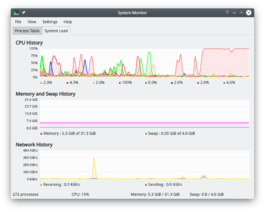 |
追蹤和控制系統中的行程。 |
概述
KSysGuard 設計成無需使用者特別設定即可進行簡單的行程控制 - 預設的通常完全夠用。有兩張工作表 - 頁(上面是圖表)和。
系統負載
屏有3個顯示圖表,每個分別描繪如下負載要素- 「CPU歷史」,「記憶體和Swap歷史」,「網絡歷史」。如果你懸停鼠標指針到每個部分的,你會看到帶有顏色的詳細分析。
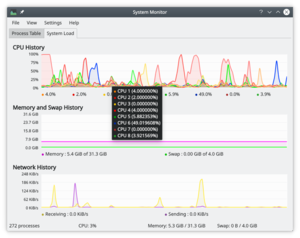 |
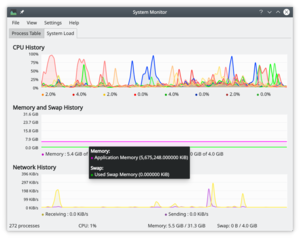 |
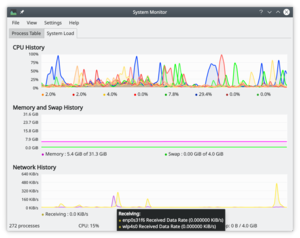 |
行程表
預設的檢視會給你一份按照字母排序的所有運行的行程清列表。點擊任何列的標題會以此列排序。如果你有一個runaway行程(這種行程陷入無限循環,不停派生出子行程),你會發現視圖最有用。你也能選擇用「擁有者」或「程式」查看行程的子集。
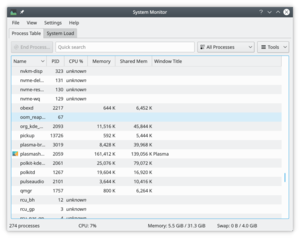 |
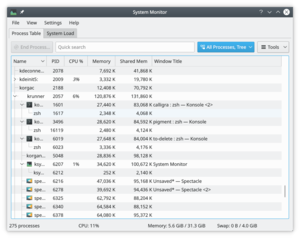 |
提示和技巧
Ctrl + Esc能啟動系統監視器的行程模組,通常在你想找出哪個程式佔用太多資源的時候非常有用。
在 KRunner (Alt + F2或是右擊桌面) 上位於輸入框左側有個小圖示-它看起來像微波爐-也能啟動行程表。
